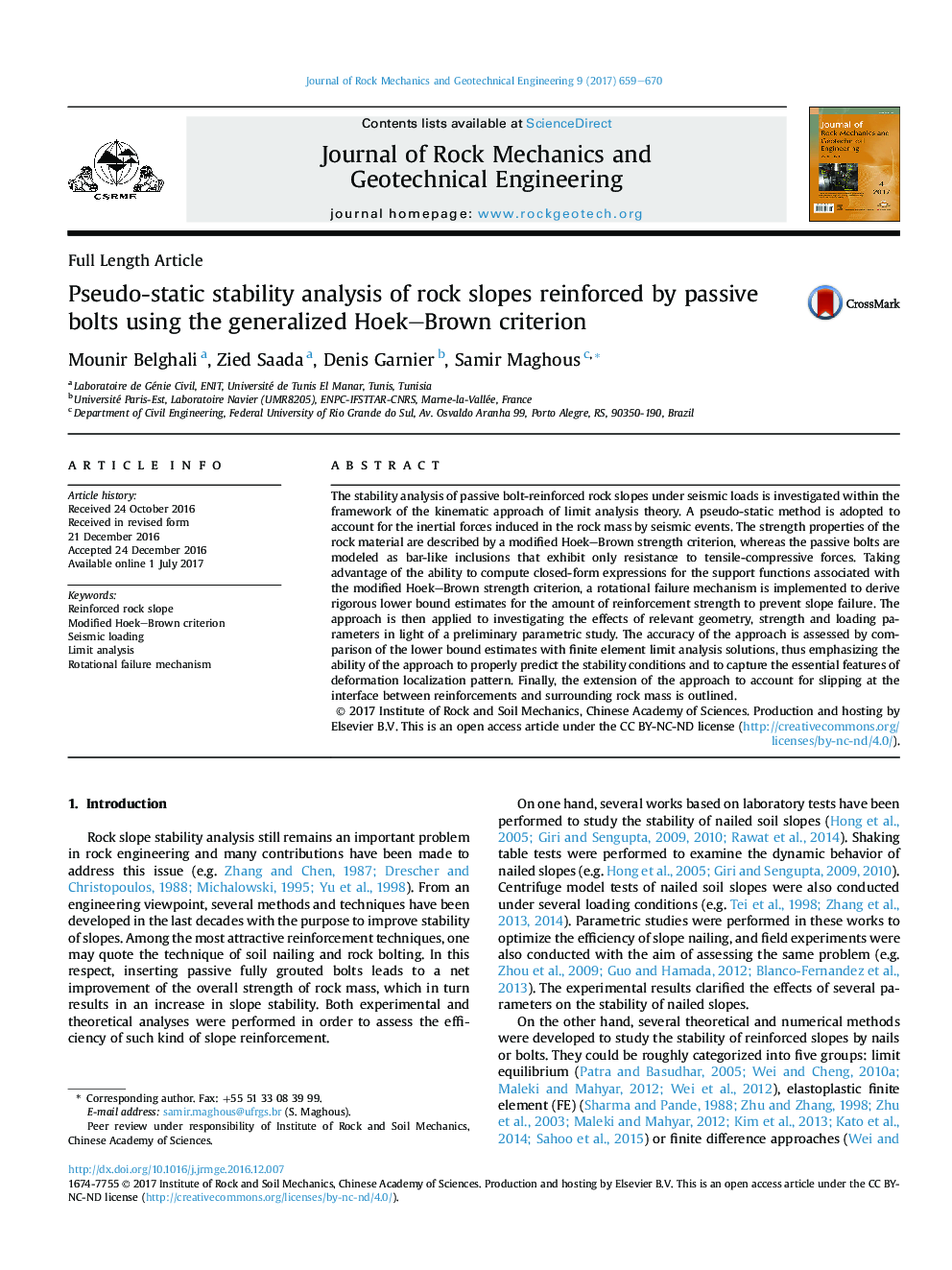| کد مقاله | کد نشریه | سال انتشار | مقاله انگلیسی | نسخه تمام متن |
|---|---|---|---|---|
| 4923730 | 1363064 | 2017 | 12 صفحه PDF | دانلود رایگان |
کلمات کلیدی
1. مقدمه
2 تعریف مساله و روش تحلیل
2-1 هندسه و نوع بارگذاری
شکل 1. نوع هندسه و بارگذاری ترانشه سنگی مطالعه شده.
2-2 مشخصات مقاومت
2-3 روش سینماتیک تحلیل حدی
3 کاربرد پایداری ترانشههای سنگی مسلح
شکل 2. مکانیزم گسیختگی لوگ-اسپیرال چرخشی ترانشه سنگی مسلح شده.
شکل 3. حرکت مجازی المان مسلح کننده اعمالی با حجم حرکت چرخشی TI1I2.
4 نتایج عددی
4-1 ارزیابی اثرات پارامترهای مقاومت سنگ
شکل 4. تاثیر مقاومت فشاری تک محوری سنگ بر مقاومت مسلح کننده مورد نیاز
4-2 اثرات پارامترهای هندسه و بارگذاری
شکل 5. مقدار مرز پائینی مقاومت مسلح کننده مورد نیاز در برابر شاخص مقاومت زمین شناسی GSI
شکل 6. تاثیر پارامتر مقاومت mi بر مقدار مرز پائینی مقاومت مسلح کننده مورد نیاز
شکل 7. مقدار مرز پائینی مقاومت مسلح کننده مورد نیاز بصورت تابعی از شیب ترانشه سنگی.
شکل 8. اثرات شدت زلزله بر مقاومت مسلح کننده مورد نیاز.
4-3 مقایسه با روشهای المان محدود
شکل 9. مش بندی المان محدود بهینه شده از تحلیل سینماتیک مرز بالایی با استفاده از نرم افزار OptumG2.
جدول 1. مقادیر مقاومت مسلح کننده مورد نیاز از روش حاضر و شبیه سازیهای المان محدود
شکل 10. میدان سرعت بهینه بدست آمده از شبیه سازیهای نرم افزار OptumG2 برای kh=0 (حالت استاتیکی).
شکل 11. میدان سرعت بهینه بدست آمده از شبیه سازیهای نرم افزار OptumG2 برای kh=0.1.
4-4 نقد
شکل 12. میدان تنش المان محدود بهینه: کنتور تابع تسلیم هوک-براون تعمیم یافته برای kh=0.
شکل 13. تعریف هندسه مکانیزم گسیختگی لغزش در سطح تماس سنگ / مسلح کنند و طول گیرداری همراه آن.
5 نتیجهگیری
پیوست
The stability analysis of passive bolt-reinforced rock slopes under seismic loads is investigated within the framework of the kinematic approach of limit analysis theory. A pseudo-static method is adopted to account for the inertial forces induced in the rock mass by seismic events. The strength properties of the rock material are described by a modified Hoek-Brown strength criterion, whereas the passive bolts are modeled as bar-like inclusions that exhibit only resistance to tensile-compressive forces. Taking advantage of the ability to compute closed-form expressions for the support functions associated with the modified Hoek-Brown strength criterion, a rotational failure mechanism is implemented to derive rigorous lower bound estimates for the amount of reinforcement strength to prevent slope failure. The approach is then applied to investigating the effects of relevant geometry, strength and loading parameters in light of a preliminary parametric study. The accuracy of the approach is assessed by comparison of the lower bound estimates with finite element limit analysis solutions, thus emphasizing the ability of the approach to properly predict the stability conditions and to capture the essential features of deformation localization pattern. Finally, the extension of the approach to account for slipping at the interface between reinforcements and surrounding rock mass is outlined.
Journal: Journal of Rock Mechanics and Geotechnical Engineering - Volume 9, Issue 4, August 2017, Pages 659-670
